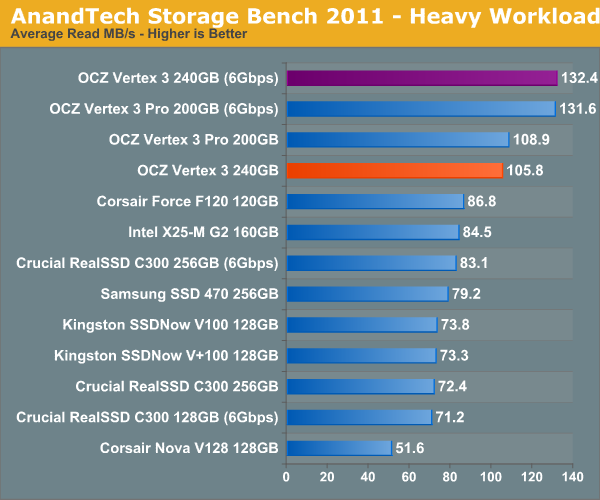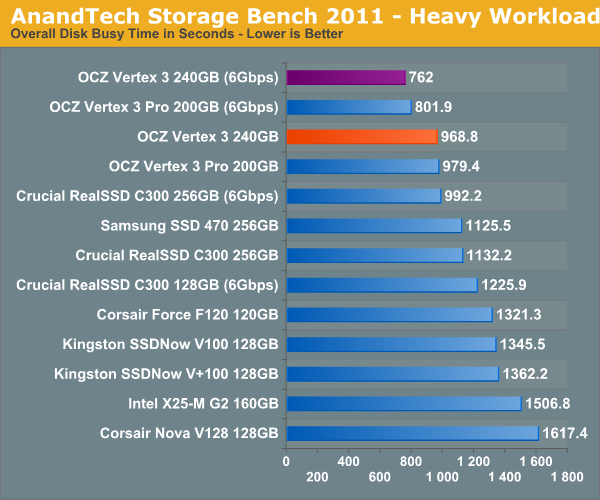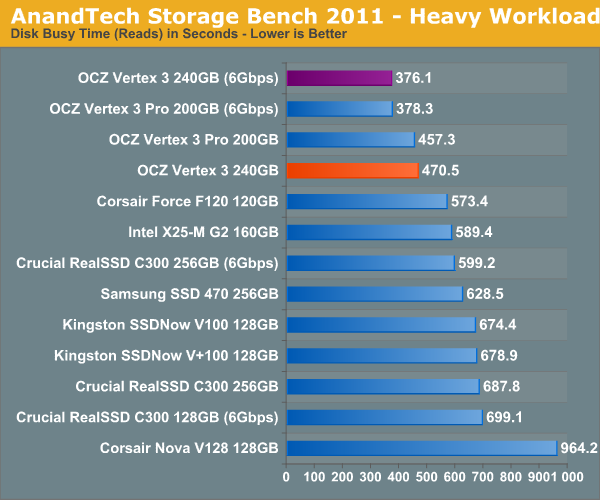OCZ Vertex 3 Preview: Faster and Cheaper than the Vertex 3 Pro
by Anand Lal Shimpi on February 24, 2011 9:02 AM ESTAnandTech Storage Bench 2011: Much Heavier
I didn't expect to have to debut this so soon, but I've been working on updated benchmarks for 2011. Last year we introduced our AnandTech Storage Bench, a suite of benchmarks that took traces of real OS/application usage and played them back in a repeatable manner. I assembled the traces myself out of frustration with the majority of what we have today in terms of SSD benchmarks.
Although the AnandTech Storage Bench tests did a good job of characterizing SSD performance, they weren't stressful enough. All of the tests performed less than 10GB of reads/writes and typically involved only 4GB of writes specifically. That's not even enough exceed the spare area on most SSDs. Most canned SSD benchmarks don't even come close to writing a single gigabyte of data, but that doesn't mean that simply writing 4GB is acceptable.
Originally I kept the benchmarks short enough that they wouldn't be a burden to run (~30 minutes) but long enough that they were representative of what a power user might do with their system.
Not too long ago I tweeted that I had created what I referred to as the Mother of All SSD Benchmarks (MOASB). Rather than only writing 4GB of data to the drive, this benchmark writes 106.32GB. It's the load you'd put on a drive after nearly two weeks of constant usage. And it takes a *long* time to run.
I'll be sharing the full details of the benchmark in some upcoming SSD articles (again, I wasn't expecting to have to introduce this today so I'm a bit ill prepared) but here are some details:
1) The MOASB, officially called AnandTech Storage Bench 2011 - Heavy Workload, mainly focuses on the times when your I/O activity is the highest. There is a lot of downloading and application installing that happens during the course of this test. My thinking was that it's during application installs, file copies, downloading and multitasking with all of this that you can really notice performance differences between drives.
2) I tried to cover as many bases as possible with the software I incorporated into this test. There's a lot of photo editing in Photoshop, HTML editing in Dreamweaver, web browsing, game playing/level loading (Starcraft II & WoW are both a part of the test) as well as general use stuff (application installing, virus scanning). I included a large amount of email downloading, document creation and editing as well. To top it all off I even use Visual Studio 2008 to build Chromium during the test.
Many of you have asked for a better way to really characterize performance. Simply looking at IOPS doesn't really say much. As a result I'm going to be presenting Storage Bench 2011 data in a slightly different way. We'll have performance represented as Average MB/s, with higher numbers being better. At the same time I'll be reporting how long the SSD was busy while running this test. These disk busy graphs will show you exactly how much time was shaved off by using a faster drive vs. a slower one during the course of this test. Finally, I will also break out performance into reads, writes and combined. The reason I do this is to help balance out the fact that this test is unusually write intensive, which can often hide the benefits of a drive with good read performance.
There's also a new light workload for 2011. This is a far more reasonable, typical every day use case benchmark. Lots of web browsing, photo editing (but with a greater focus on photo consumption), video playback as well as some application installs and gaming. This test isn't nearly as write intensive as the MOASB but it's still multiple times more write intensive than what we were running last year.
As always I don't believe that these two benchmarks alone are enough to characterize the performance of a drive, but hopefully along with the rest of our tests they will help provide a better idea.
The testbed for Storage Bench 2011 has changed as well. We're now using a Sandy Bridge platform with full 6Gbps support for these tests. All of the older tests are still run on our X58 platform.
AnandTech Storage Bench 2011 - Heavy Workload
We'll start out by looking at average data rate throughout our new heavy workload test:

If we break out our performance results into average read and write speed we get a better idea for the Vertex 3's strengths:


The next three charts just represent the same data, but in a different manner. Instead of looking at average data rate, we're looking at how long the disk was busy for during this entire test. Note that disk busy time excludes any and all idles, this is just how long the SSD was busy doing something:













85 Comments
View All Comments
seapeople - Thursday, February 24, 2011 - link
I think the answer you are searching for is a bit more mundane than you desire. For example, when you load a map you are storage limited whether you have an SSD or not, and when you are fighting bad guys you are CPU limited whether you have a slow HD or not.vol7ron - Saturday, February 26, 2011 - link
While that's true, I'm not sure that's what he's referring to.If you're ever CPU limited, it's probably not just because of an SSD, it's just the fact that you need a better CPU. Generally, CPU limitations are apparent from memory access, not due to SSDs.
I can understand what he's saying though as I'm still running a C2D and it gets to 100% during games. Not to mention, there does seems to be hang ups on Win7 64b startup, due to all the applications, widgets, and services that load; but that's less to do with the SSD and more to do with the CPU. The load time would be just as long w/o the SSD, it's just that there wouldn't be as much of a hang-up as the sluggishness would be constant.
Having more cores in this instance would certainly help.
Nentor - Thursday, February 24, 2011 - link
First paragraph:"What wasn’t impressive however was the price."
There is not a word about price in the article about the V3Pro. Not even a slight indication implying a high price which made it seem affordable.
Also this:
---I asked OCZ if this meant the drive I was testing wasn’t representative of final, shipping performance. OCZ stated very clearly that performance will not change between the drive I have today and the drive that goes on sale in the next 2 months.
SandForce wouldn’t comment on any existing agreements and OCZ said it couldn’t get SandForce to confirm that the V3’s performance wouldn’t change between now and its eventual release.---
What exactly does that mean? It comes down to not meaning anything at all to me.
ClagMaster - Thursday, February 24, 2011 - link
I went half-way through this article and was frustrated with the complexity of the SandForce Controller capabilities and firmware games.It would seem SandForce is very Intel-like in its conduct. Why cannot they have 2-3 stinking controllers setup for maximum performance without these firmware games ? The hardware is willing but the businessmen are not.
Last night I was about ready to purchase a 120GB SSD but decided this was an extravagance for my desktop for $220. I would rather have a good Western Digital Black 1.0 TB harddrive than this SSD. I get much more for my money. I still use Windows XP Home because of its efficiency and minimalist memory foot print. Are there any garbage collection utilities I can use for this still excellent OS? This is not clear from the vendor sights.
Can anyone enlighten me as to what is available for Windows XP so these SSD's continue to operate in prime form ?
I cannot believe consumers are willing to pay this kind of money so they shave off 15 to 20 seconds off boottimes.
86waterpumper - Thursday, February 24, 2011 - link
I agree whole-heartedly with you about the frimware games...that is def. lameness.With that being said, I don't think that ocz drives are really more expensive than other brands so I guess the solution for now is just to buy their drives instead of the competitions which is exactly what they want right? haha.
I disagree though with you about ssd not being worth it. I know they are high, but shaving 15 to 20 seconds off boot time is huge in my book. I mean that is half the time in alot of cases. That has a coolness factor to it, but the main benefit I see is being
able to multitask better, and having programs and games load faster. The boot time is just a side benefit really. Quietness and low heat and power draw are other nice features. Anyway I remember people were happy to pay the price for raptors not long ago, and they were this expensive and much less capacity than regular drives. They did not represent nearly the performance gap either.
Barbaniko - Thursday, February 24, 2011 - link
Anand,How about Garbage collection on the Vertex 3?
How would it hold up over time without access to winnows 7 trim command?
I am interested in putting two of these in a Raid 0 configuration.
Thank you.
arm3n - Monday, February 28, 2011 - link
I second this request. Would love to get your take on these bad boys striped.Thanks!
Armen
gstrickler - Friday, February 25, 2011 - link
Anand,I've been searching for reliable information about the AES encryption on SF based SSDs. From the information I've been able to get from the manufacturers, this is NOT TCG "OPAL" compatible FDE, it's passive encryption that does not require any BIOS support, TCM, or boot time password. If that's accurate, then it's almost useless. It doesn't protect your data if your SSD is stolen. Therefore, it is of limited value.
What that does do is protect the data from being recovered from the NAND Flash chips on a failed SSD, and executing a "erase" ATA command will change the password and make all your data, including bad blocks and reserved overallocation areas, inaccessible after the erase. Clearly, that has value to those reallocating a used drive, but that's about the extent of it's value.
There is certainly some value in that, as securely erasing the data from an SSD can be challenging because of the LBA->Flash block remapping that SSDs perform. However, if it doesn't support "OPAL" FDE, then you must fall back to software FDE and the performance penalty for software FDE on an SSD is far more significant than it is for a HDD, and effectively eliminates much of the performance benefit of an SSD.
Please check with SandForce and/or the SSD vendors and report if any of them support TCG compatible "OPAL" FDE. That information is vital to users who need to use FDE.
ac2 - Friday, February 25, 2011 - link
+1The AES encryption bit sounds like one of those meaningless marketing bullet points...
iwod - Friday, February 25, 2011 - link
The Anand SSD benchmarks 2010 and 2011 are the closest we get to real life measurements.And if those results are correct. Then our previous estimation of Seq Read Write become not important as we move faster will be incorrect. It turns out most of our time we are doing Seq Read Write. Therefore it is the Random Read Write has reach its tipping point and not providing any more Real World Improvement to users.